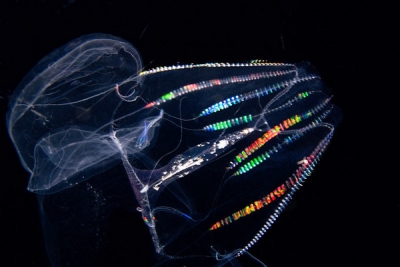
Comb Jellies are fascinating creatures that have special features- rows of ‘comb’ with hair-like structures called cilia, evenly spaced around their bodies. The organism uses these cilia like oars to swim in the water. Comb jellies are known for generating dramatic rainbows of colours along the comb-rows while swimming. But that’s not bioluminescence- it occurs when light is scattered in different directions by the movement of cilia. But comb jellies also secrete luminescent ink that serves to distract predators providing time for them to escape.
Until 2015 scientists believed that comb jellies removed their waste via their “mouth,” or what was believed to be the one hole in their body plan. A new study showed that comb jellies in fact release indigestible particles through pores on the rear end of the animal. This discovery adds another piece to the evolutionary puzzle of when animals evolved to have anuses.
Many comb jellies have a single pair of tentacles (often each tentacle is branched, giving the illusion of many tentacles) that they use like fishing lines to catch prey. They are armed with sticky cells (colloblasts) and unlike jellyfish, the tentacles of comb jellies don’t sting.
Picture Credit : Google

